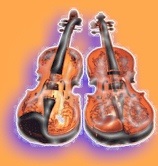 Karen Marshalsay’s CD of harp music The Road To Kennacraig – due for release on 15th July 2019 – shows her to be a fine harpist specialising in traditional music and compositions of her own in that same tradition, with a particular interest in transferring pipe music to the harp. On this CD she plays three harps: a wire-strung clàrsach from Ardival Harps, a gut-strung lever harp from Jack Yule, and a Baroque bray harp, also from Ardival. (On track 5 she also plays a boxwood D whistle from Jon Swayne.) On most of the tracks here, she plays the gut-strung harp: I’ve noted exceptions below.
Karen Marshalsay’s CD of harp music The Road To Kennacraig – due for release on 15th July 2019 – shows her to be a fine harpist specialising in traditional music and compositions of her own in that same tradition, with a particular interest in transferring pipe music to the harp. On this CD she plays three harps: a wire-strung clàrsach from Ardival Harps, a gut-strung lever harp from Jack Yule, and a Baroque bray harp, also from Ardival. (On track 5 she also plays a boxwood D whistle from Jon Swayne.) On most of the tracks here, she plays the gut-strung harp: I’ve noted exceptions below.
Here’s the track list:
- ‘The Road To Kennacraig’ was composed by Karen and is played on the clàrsach, which has a clearer, cooler tone than the gut-strung harp. From a sparse opening, the melody develops into a series of variations incorporating the type of ornamentation characteristic of pipe music.
- ‘St Fillan’s’ / ‘The Rhymer’s Reel’: the first tune is a slow air taken from the 1895 Gesto Collection Of Highland Music, published by Keith Norman MacDonald, and to my ear has a somewhat Irish feel, not inappropriately given Fillan’s Irish connections. The second tune is a reel composed by Karen and part of a longer piece called ‘Thomas The Rhymer’, an instrumental interpretation of the adventures in Elfland of Sir Thomas de Ercildoun, as told in various romances and Child ballad number 37 ‘Thomas Rymer’. I was rather gratified to find a recording of the longer piece with fuller instrumentation on SoundCloud.
- ‘The Journeying Jig’ is another of Karen’s compositions, featuring variations similar to the extended variations of the pibroch or ceòl mòr form mostly associated with piping, though Karen’s is a name often heard in respect of the fairly recent revival using the clàrsach. While we are sometimes conditioned to expect a jig to be an energetic dance tune in an exotic time signature, this is a gentle piece in Em that explores the migration of pipe voicings to the harp. Very interesting.
- ‘Jane Pickeringe’s Lilt’ / ‘Emma’: the first is an (originally unnamed) tune taken from a book owned by Jane Pickeringe in 1616, seguing very effectively into a traditional Finnish waltz.
- ‘Ülle’s Reel’ is a slow reel written by piper John Saunders, and features whistle as well as harp: the warmth of the boxwood whistle and gut-strung harp make for a particularly attractive combination.
- ‘Ellen’s Dreams’ / ‘Pipe Major Donald MacLean Of Lewis’: the first is a tune by Robin Morton, perhaps best known as a member of the Boys of the Lough, who has added this album to his long list of credits as a producer. Unsurprising, it feels very Irish. The second is a contrasting march written by Pipe Major Donald MacLeod in honour of one of his contemporaries.
- The wire-strung clàrsach features again on the melodically simple but effective ‘Carrill’s Lament’, taken from James Oswald’s 18th Century collection Caledonian Pocket Companion.
- ‘Bert Mackenzie’s 70th Birthday Waltz’ / ‘Isabel Gow’s Welcome To Edinburgh’ features two modern pieces: the waltz was written by Louise Mackenzie, modulating with a sudden but rather effective change of key and mode into a march by Karen.
- ‘The Battle Of The Bridge Of Perth’ is traditional pibroch learned from Allan MacDonald, played on the clàrsach. Karen does a remarkable job of approximating the sound of the pipes here.
- ‘Helen’s Farewell’ is another composition by Karen: unsurprisingly, the arrangement has a much more modern feel, though the melody sits squarely in a traditional form.
- ‘Dr Karen McAuley Of The Books’ is another of Karen’s compositions, though I can perfectly well imagine it turning up at a tunes session. Probably played three times faster by a speedfreak accordionist. However, it’s very nice indeed at the gentler pace featured here.
- ‘The Rhymer’s March’ / ‘MacKinnon’s Brook’: the first tune is another segment from Karen’s ‘Thomas The Rhymer’, followed by a traditional strathspey. Both the wire-strung clàrsach and the gut-strung lever harp are featured here, along with the bray harp. (A wooden bray pin can be set to touch the base of each string, giving the bray harp a characteristic buzz – resembling the resonance of the sympathetic strings of instruments such as sitar and sarod – and also increasing projection.)
Perhaps it’s because of the Marmite sound of the Scottish pipes, but I think we sometimes underestimate the art of pibroch. Certainly my ears have been opened by this CD to a whole new appreciation of the genre, as well as to the instrumental artistry and compositional prowess of Karen herself. I hope to hear a great deal more of her in the future: in the meantime, I suspect I’ll be listening to this CD quite a lot. Indeed, I’m already thinking that some of those pieces might transfer well to the guitar…
David Harley
Artist’s website: www.karenmarshalsay.com
‘The Rhymer’s March/Cath Raon Ruaridh’ – live:
 Thanks for stopping by. Please help us continue and support us by tipping/donating to folking.com via
Thanks for stopping by. Please help us continue and support us by tipping/donating to folking.com via
You must be logged in to post a comment.